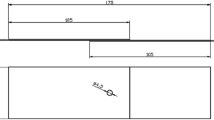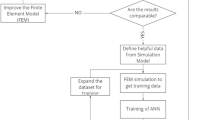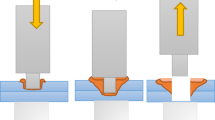Abstract
The use of welded lightweight steels in structural applications is increasing due to the greater design possibilities offered by such materials and the lower costs compared to conventional steels. Ultra-high-strength steels (UHSS) having tensile strength of up to 1700 MPa with a high strength-to-weight ratio offer a unique combination of qualities for diverse industrial applications. For productivity and quality reasons, gas metal arc welding (GMAW) is usually utilized for welding of UHSS. However, for full penetration fillet welded joints, the need for high heat input to gain acceptable weld penetration is problematic when welding UHSS. This is due to UHSS sensitivity to heat input and possible heat-affected zone (HAZ) softening. In this paper, an attempt is made, on the basis of analysis of experimental reviews, to identify and define relationships between nonlinear weldability factors to enable creation of an artificial intelligence model to predict full penetration in robotic GMAW fillet welded joints of UHSS S960QC. Welding variables and parameters associated with GMAW are first evaluated by reviewing scientific literature. The possibility of employing an artificial neural network (ANN) to predict full penetration fillet weld characteristics is then examined. It is noted that nonlinear variables associated with the GMAW process, such as heat input, contact tip to work distance (CTWD), and torch angle, and their related parameters, which pose weldability challenges, can be modeled by applying artificial intelligence systems. Ensuring full penetration in fillet welded joints of UHSS using artificial intelligence is thus feasible. Further, an optimized control system could potentially be developed by incorporating adaptive robotic GMAW with an artificial intelligence-based system to guarantee sound structural integrity that conforms to EN ISO 5817. The paper increases awareness of welding aspects of UHSS S960QC and presents an approach for overcoming existing limits to GMAW via adaptive robotic welding and artificial intelligence systems.
Similar content being viewed by others
References
Hemmilä M, Laitinen R, Liimatainen T, Porter D (2010) Mechanical and technological properties of ultra high strength Optim steels. Rautaruukki Oyj, Ruukki Production, Helsinki. http://www.oxycoupage.com/FichiersPDF/Ruukki_Pdf/English/Ruukki-Technical-article-Mechanical-and-technological-properties-of-ultra-high-strength-Optim-steels.pdf. Accessed 20 April 2016
Kah P, Pirinen M, Suoranta R, Martikainen J (2014) Welding of ultra high strength steels. Adv Mater Res 849:357–365
Björk T, Toivonen J, Nykänen T (2012) Capacity of fillet welded joints made of ultra-high strength steel. Weld World 57:71–84
Laitinen R, Valkonen I, Kömi J (2013) Influence of the base material strength and edge preparation on the fatigue strength of the structures made by high and ultra-high strength steels, 5th Fatigue Design Conference, Fatigue Design. Science Direct. Procedia Eng 66:282–291
Hicks J (2001) Welded design—theory and practice, Woodhead Publishing Ltd, Cambridge. Elsevier. Chapter 4, p 36–41
Finnish Standards Association (SFS): welding—fusion-welded joints in steel, nickel, titanium and their alloys (beam welding excluded)—quality levels for imperfections (ISO 5817:2014)
Hemmilä M, Laitinen R, Liimatainen T, Porter D (2005) Mechanical and technological properties of ultra high strength Optim steels. Rautaruukki Corporation, Helsinki
Jae-Woong K, Jun-Young L (2008) A control system for uniform bead in fillet arc welding on tack welds. J Mech Sci Technol 22:1520–1526
Shi L, Tian X, Zhang C (2015) Automatic programming for industrial robot to weld intersecting pipes. Int J Adv Manuf Technol 81:2099–2107
Ahiale GK, Oh Y-J, Choi W-D, Lee K-B, Jung J-G, Nam SW (2013) Microstructure and fatigue resistance of high strength dual phase steel welded with gas metal arc welding and plasma arc welding processes. Met Mater Int 19:933–939
Nele L, Sarno E, Keshari A (2013) Modeling of multiple characteristics of an arc weld joint. Int J Adv Manuf Technol 69:1331–1341
Jaime A-V F, Reyes R-C, Ismael L-J (2016) On-line learning of welding bead geometry in industrial robots. Int J Adv Manuf Technol 83:217–231
Moon H-S, Na S-J (1997) Optimum design based on mathematical model and neural network to predict weld parameters for fillet joints. J Manuf Syst 16:13–23
Son JS, Kim IS, Kim HH, Kim IJ, Kang BY, Kim HJ (2007) A study on the prediction of bead geometry in the robotic welding system. J Mech Sci Technol 21:1726–1731
Xiong J, Zhang G, Hu J, Wu L (2014) Bead geometry prediction for robotic GMAW-based rapid manufacturing through a neural network and a second-order regression analysis. J Intell Manuf 25:157–163
Lin H-L, Yan J-C (2014) Optimization of weld bead geometry in the activated GMA welding process via a grey-based Taguchi method. J Mech Sci Technol 28:3249–3254
DebRoy T, Kou S, Tsai C (2001) Heat flow in welding: welding handbook chapter committee. Chapter 3, American Welding Society (AWS)
Gunaraj V, Murugan N (2002) Prediction of heat-affected zone characteristics in submerged arc welding of structural steel pipes. Weld J 81:94–98
Ibrahim Khan M (2007) Welding science and technology. New Age International Publishers, New Delhi
Howard BC, Scott CH (2005) Modern welding technology, 6th edn. Pretice Hall, United States of America
Nagesh DS, Datta GL (2002) Prediction of weld bead geometry and penetration in shielded metal arc welding using artificial neural networks. J Mater Process Technol 123:303–312
Nadzam J (2014) Gas metal arc welding: production and procedure selection—The Lincoln Electric Company. http://www.lincolnelectric.com/assets/global/products/consumable_miggmawwires-superarc-superarcl-56/c4200.pdf. Accessed 20 April 2016
Robert Messler Jr W (2004) Principles of welding: processes, physics, chemistry and metallurgy. WILEY-VCH Verlag GmbH & Co. KGaA, Weinheim
Weman K, Gunnar L (2006) MIG welding guide. Woodhead Publishing and Maney Publishing, Cambridge
Weman K (2003) Welding process handbook. Woodhead Publishing Limited, Cambridge
Naidu DS, Ozcelik S, Moore K (2003) Modeling, sensing and control of gas metal arc welding, 1st edn. Elsevier, Kidlington
Kah P, Latifi H, Suoranta R, Martikainen J, Pirinen M (2014) Usability of arc types in industrial welding. Int J Mech Mater Eng 9(15):1–12
Jackson CE, Shrubsall AE (1953) Control of penetration and melting ratio with welding technique. Weld J 32(4):172–178
Kovacevic R, Zhang YM, Li L (1996) Monitoring of weld joint penetration based on weld pool geometrical appearance. Welding Research Supplement 317-s, University of Kentucky, Lexington, KY
Li J, Li H, Wei H, Gao Y (2016) Effect of torch position and angle on welding quality and welding process stability in pulse on pulse MIG welding–brazing of aluminum alloy to stainless steel. Int J Adv Manuf Technol 84:705–716
Pires JN, Loureiro A, Bölmsjo G (2006) Welding robots: technology, systems issues and applications. Springer-Verlag, London Limited, p74
Kah P, Shrestha M, Martikainen J (2015) Robotic arc welding sensors and programming in industrial applications. Mater Eng 10:13
Bolmsjö G, Olsson M (2005) Sensors in robotic arc welding to support small series production. Ind Robot Int J 32(4):341–345
Kim I-S, Son J-S, Lee S-H, Yarlagadda PKDV (2004) Optimal design of neural networks for control in robotic arc welding. Robot Comput Integr Manuf 20(1):57–63
Chan B, Pacey J, Bibby M (1999) Modelling gas metal arc weld geometry using artificial neural network technology. Can Metall Q 38(1):43–51
Sreeraj P, Kannan T (2012) Modelling and prediction of stainless steel clad bead geometry deposited by GMAW using regression and artificial neural network models. Adv Mech Eng. doi:10.1155/2012/237379
Mvola B (2016) Adaptive gas metal arc welding control and optimization of welding parameters output: influence of welded joints. Int Rev Mech Eng 20:67–72
S-R JJ (1993) ANFIS: adaptive network-based fuzzy inference systems. IEEE Trans Syst Man Cybern 23:665–685
Negnevitsky M (2002) Artificial intelligence: a guide to intelligent systems. Addison-Wesley, Pearson Education Limited
Yadav N, Yadav A, Kumar M (2015) An introduction to neural network methods for different equations. Springer Briefs in Applied Sciences and Technology. Computational Intelligence. Springer Science + Business Media B.V, Dordrecht
Al-Faruk A, Md AH, Ahmed N, Kumar Das U (2010) Prediction of weld bead geometry and penetration in electric arc welding using artificial neural networks. Int J Mech Mechatron Eng 10:19–24
Juang SC, Tarng YS, Lii HR (1998) A comparison between the back-propagation and counter-propagation networks in the modeling of TIG welding process. J Mater Process Technol 75:54–62
Gyasi EA, Kah P (2016) Structural integrity analysis of the usability of high strength steels. Rev Adv Mater Sci 46:39–52
Fuller R (2000) Introduction to neuro-fuzzy systems: advances in soft computing. Physica-Verlag, New York, Heidelberg
Author information
Authors and Affiliations
Corresponding author
Rights and permissions
About this article
Cite this article
Gyasi, E.A., Kah, P., Wu, H. et al. Modeling of an artificial intelligence system to predict structural integrity in robotic GMAW of UHSS fillet welded joints. Int J Adv Manuf Technol 93, 1139–1155 (2017). https://doi.org/10.1007/s00170-017-0554-0
Received:
Accepted:
Published:
Issue Date:
DOI: https://doi.org/10.1007/s00170-017-0554-0




